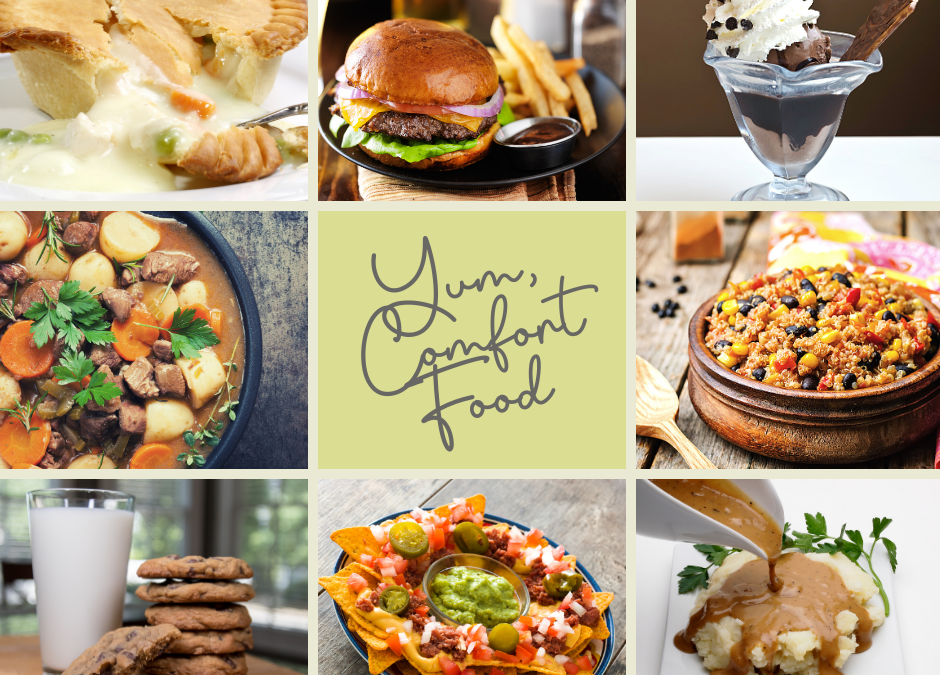What is it and why do we crave it? By Mark Szabo
Comfort Food is a concept that is ubiquitous across every civilization, every country, on every continent. We all have our favorite comfort food, but these foods vary from person-to-person, and culture-to-culture. For one person it may be Kebab’s, another might prefer Chicken Soup, others may lean towards Falafel, or Pizza, or Chili. Ice Cream is a popular comfort food that seems to bridge cultures.
What is it about comfort foods that draws us to them? Scientists have organized these cravings into four categories: Nostalgic, Indulgence, Convenience, and Physical Comfort foods.
Nostalgic foods, as you can imagine, remind us of a simpler time when we were children. They tend to be the foods Mom or Dad used to make to cheer us up. They usually have the same effect on our mood when we eat them as adults, partly because they temporarily redirect our emotions back to when we were cared for as kids.
Indulgence foods are typically things that we know aren’t “good for us,” but we eat when we want to “give in,” or as a reward to ourselves. For me, this would be something like Chocolate Cake, or Coconut Custard Pie.
Convenience foods are foods that are already prepared for us, ready-to-eat with little to no effort. These could be things like Hostess Pies, or Potato Chips, or a Snickers bar, for example.
Physical Comfort foods may overlap with the other categories and are foods that trigger the release of endorphins and act to modify the mood. For me, this would be Chocolate or Ice Cream. You probably have a short list of go-to foods that serve this purpose as well.
The thing with Comfort Foods, is that they have a tendency to be high in calories, fats, salt, or sugar, which engage the reward system in the brain giving us a temporary distinctive pleasure or emotional elevation and relaxation.
In the short-term, this isn’t such a bad thing. We get a “hit” of dopamine from the brain, and then our bodies process our indulgence, storing excess calories as fat, circulating insulin to manage the sugar, and doing its best to incorporate the resulting molecules from digestion into various structures in the body.
The problem comes in with long-term indulgences; when we start eating food as a way to medicate our feelings on a regular basis. This can lead to chronic conditions and diseases, like diabetes, gout, acne, and cancer, to name a few.
So, is it possible to make foods that are comforting, yet still nourishing for the body? Yes! There are numerous “tweaks” you can make to a recipe to make it healthier, yet still taste good enough to trigger the reward system in the brain.
For example, I make a killer Chicken Pot Pie that everyone loves, but it’s super-duper unhealthy. To make it, I combine cream cheese, condensed cream of chicken soup, diced chicken meat, and frozen vegetables into a frozen pie shell, then top it with what essentially amounts to pancake batter in the form of Bisquick to form the top crust.
It tastes amazing, but eating this on a routine basis would clog even a horse’s arteries.
Kathi was in the mood for chicken pot pie the other day, but knowing how bad my “traditional” pot pie recipe would be for us, she did some searching and found one that’s much better for our bodies.
This recipe called for chopped onion, celery, and carrots and three cups of broth, with some thyme and oregano for good measure, to be poured into a slow cooker over top of two whole chicken breasts. Cook on low for 4-6 hours, remove and shred the chicken, place a cup and a half of the resulting veggies in liquid into a blender and blend until smooth, return everything back to the crock pot, then add frozen peas, corn, carrots, and pearl onions to the pot, top with half a cup of Greek yogurt, then stir and cook on low for about another half hour, or until the frozen veggies are heated through. (The next time I make it, I’m just going to use a bag of frozen veggies and skip the pearl onions. I’ll probably pick up some fresh thyme and oregano, and maybe rosemary too.)
It came out great! No, it wasn’t exactly the same as my normal chicken pot pie, and there was no pie crust involved, but it was much healthier while still tasting amazing with a good “mouth feel.” Kathi and I discovered that we’re not crazy about pearl onions; but hey, we learned something by experimenting!
The point here is, you can make food that hits your taste buds the right way, yet doesn’t add to your waistline or hurt your heart in the long run.
Speaking of which, if you’re interested in learning to make chili that people will devour and compliment you on, but is fantastically healthy to eat, check out my next LIVE nutrition call where I’ll be making said chili while you watch or cook along with me. Save the date: February 17th at 6:00 pm EST! Register here.
And if you want to go in-depth with learning how to eat healthily and sustainably, schedule a quick 30-minute call with me to learn more about my 10-week program, Metabolic Mindfulness: Shifting Thoughts to a Healthy Lifestyle. Learn how to live so you’ll never need to “go on a diet” again for the rest of your life.


Recent Comments